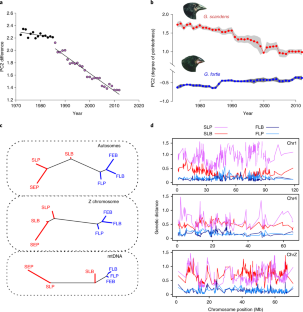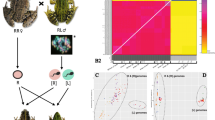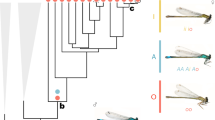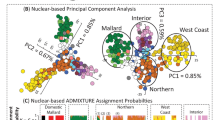Abstract
The mosaic nature of hybrid genomes is well recognized, but little is known of how they are shaped initially by patterns of breeding, selection, recombination and differential incompatibilities. On the small Galápagos island of Daphne Major, two species of Darwin’s finches, Geospiza fortis and G. scandens, hybridize rarely and back-cross bidirectionally with little or no loss of fitness under conditions of plentiful food. We used whole-genome sequences to compare genomes from periods before and after successful interbreeding followed by back-crossing. We inferred extensive introgression from G. fortis to G. scandens on autosomes and mitochondria but not on the Z chromosome. The unique combination of long-term field observations and genomic data shows that the reduction of gene flow for Z-linked loci primarily reflects female-biased gene flow, arising from a hybrid-male disadvantage in competition for high-quality territories and mates, rather than from genetic incompatibilities at Z-linked loci.
This is a preview of subscription content, access via your institution
Access options
Access Nature and 54 other Nature Portfolio journals
Get Nature+, our best-value online-access subscription
$29.99 / 30 days
cancel any time
Subscribe to this journal
Receive 12 digital issues and online access to articles
$119.00 per year
only $9.92 per issue
Buy this article
- Purchase on Springer Link
- Instant access to full article PDF
Prices may be subject to local taxes which are calculated during checkout




Similar content being viewed by others
Data availability
The Illumina reads have been submitted to the short reads archive (http://www.ncbi.nlm.nih.gov/sra) under accession number PRJNA530015. The following figures have associated raw data: Fig. 1a,b and Extended Data Fig. 1. The raw data are available in Supplementary Table 1.
Code availability
The analyses of the data were carried out with publicly available software, and all are cited in the Methods. The custom scripts used are available at https://github.com/sangeet2019/Darwins-Finches.
References
Mayr, E. Animal Species and Evolution (Harvard Univ. Press, 1963).
Abbott, R. et al. Hybridization and speciation. J. Evol. Biol. 26, 229–246 (2013).
Suarez-Gonzalez, A., Lexer, C. & Cronk, Q. C. B. Adaptive introgression: a plant perspective. Biol. Lett. 14, 20170688 (2018).
Taylor, S. A. & Larson, E. L. Insights from genomes into the evolutionary importance and prevalence of hybridization in nature. Nat. Ecol. Evol. 3, 170–177 (2019).
Edwards, S. V., Potter, S., Schmitt, C. J., Bragg, J. G. & Moritz, C. Reticulation, divergence, and the phylogeography–phylogenetics continuum. Proc. Natl Acad. Sci. USA 113, 8025–8032 (2016).
Elgvin, T. O. et al. The genomic mosaicism of hybrid speciation. Sci. Adv. 3, e1602996 (2017).
vonHoldt, B. M. et al. Whole-genome sequence analysis shows that two endemic species of North American wolf are admixtures of the coyote and gray wolf. Sci. Adv. 2, e1501714 (2016).
Larsen, P. A., Marchan-Rivadeneira, M. R. & Baker, R. J. Natural hybridization generates mammalian lineage with species characteristics. Proc. Natl Acad. Sci. USA 107, 11447–11452 (2010).
Carling, M. D., Lovette, I. J. & Brumfield, R. T. Historical divergence and gene flow: coalescent analyses of mitochondrial, autosomal and sex-linked loci in Passerina buntings. Evolution 64, 1762–1772 (2010).
Payseur, B. A. & Rieseberg, L. H. A genomic perspective on hybridization and speciation. Mol. Ecol. 25, 2337–2360 (2016).
Jones, M. R. et al. Adaptive introgression underlies polymorphic seasonal camouflage in snowshoe hares. Science 360, 1355–1358 (2018).
Liu, K. J. et al. Interspecific introgressive origin of genomic diversity in the house mouse. Proc. Natl Acad. Sci. USA 112, 196–201 (2015).
Fontaine, M. C. et al. Extensive introgression in a malaria vector species complex revealed by phylogenomics. Science 347, 1258524 (2015).
Arnold, M. L. & Kunte, K. Adaptive genetic exchange: a tangled history of admixture and evolutionary innovation. Trends Ecol. Evol. 32, 601–611 (2017).
Pereira, R. J., Barreto, F. S. & Burton, R. S. Ecological novelty by hybridization: experimental evidence for increased thermal tolerance by transgressive segregation in Tigriopus californicus. Evolution 68, 204–215 (2014).
Hedrick, P. W. Adaptive introgression in animals: examples and comparison to new mutation and standing variation as sources of adaptive variation. Mol. Ecol. 22, 4606–4618 (2013).
Lewontin, R. C. & Birch, L. C. Hybridization as a source of variation for adaptation to new environments. Evolution 20, 315–336 (1966).
Campbell, C. R., Poelstra, J. W. & Yoder, A. D. What is speciation genomics? The roles of ecology, gene flow, and genomic architecture in the formation of species. Biol. J. Linn. Soc. 124, 561–583 (2018).
Heliconius Genome Consortium. Butterfly genome reveals promiscuous exchange of mimicry adaptations among species. Nature 487, 94–98 (2012).
Schumer, M., Rosenthal, G. G. & Andolfatto, P. How common is homoploid hybrid speciation? Evolution 68, 1553–1560 (2014).
Meier, J. I. et al. Ancient hybridization fuels rapid cichlid fish adaptive radiations. Nat. Commun. 8, 14363 (2017).
Barrera-Guzman, A. O., Aleixo, A., Shawkey, M. D. & Weir, J. T. Hybrid speciation leads to novel male secondary sexual ornamentation of an Amazonian bird. Proc. Natl Acad. Sci. USA 115, E218–E225 (2018).
Barrera-Guzmán, A. O., Aleixo, A., Shawkey, M. D. & Weir, J. T. Reply to Rosenthal et al.: both premating and postmating isolation likely contributed to manakin hybrid speciation. Proc. Natl Acad. Sci. USA 115, E4146–E4147 (2018).
Burns, K. J. et al. Phylogenetics and diversification of tanagers (Passeriformes: Thraupidae), the largest radiation of Neotropical songbirds. Mol. Phylogenet. Evol. 75, 41–77 (2014).
Lamichhaney, S. et al. Evolution of Darwin’s finches and their beaks revealed by genome sequencing. Nature 518, 371–375 (2015).
Sato, A. et al. Phylogeny of Darwin’s finches as revealed by mtDNA sequences. Proc. Natl Acad. Sci. USA 96, 5101–5106 (1999).
Peters, K. J., Myers, S. A., Dudaniec, R. Y., O’Connor, J. A. & Kleindorfer, S. Females drive asymmetrical introgression from rare to common species in Darwin’s tree finches. J. Evol. Biol. 30, 1940–1952 (2017).
Grant, P. R. Ecology and Evolution of Darwin’s Finches (Princeton Univ. Press, 1999).
Grant, P. R. & Grant, B. R. 40 Years of Evolution: Darwin’s Finches on Daphne Major Island (Princeton Univ. Press, 2014).
Grant, P. R. & Grant, B. R. Conspecific versus heterospecific gene exchange between populations of Darwin’s finches. Phil. Trans. R. Soc. B 365, 1065–1076 (2010).
Grant, B. R. & Grant, P. R. Evolution of Darwin’s finches caused by a rare climatic event. Proc. R. Soc. Lond. B 251, 111–117 (1993).
Grant, P. R. & Grant, B. R. Hybridization of bird species. Science 256, 193–197 (1992).
Stemshorn, K. C., Reed, F. A., Nolte, A. W. & Tautz, D. Rapid formation of distinct hybrid lineages after secondary contact of two fish species (Cottus sp.). Mol. Ecol. 20, 1475–1491 (2011).
Mallet, J., Besansky, N. & Hahn, M. W. How reticulated are species? Bioessays 38, 140–149 (2016).
Kearns, A. M. et al. Genomic evidence of speciation reversal in ravens. Nat. Commun. 9, 906 (2018).
Joseph, L., Drew, A., Mason, I. J. & Peters, J. L. Introgression between non-sister species of honeyeaters (Aves: Meliphagidae) several million years after speciation. Biol. J. Linn. Soc. 128, 583–591 (2019).
Zhang, G., Parker, P., Li, B., Li, H. & Wang, J. The genome of Darwin’s finch (Geospiza fortis). GigaScience https://doi.org/10.5524/100040 (2012).
Baack, E. J. & Rieseberg, L. H. A genomic view of introgression and hybrid speciation. Curr. Opin. Genet. Dev. 17, 513–518 (2007).
Rheindt, F. E. & Edwards, S. V. Genetic introgression: an integral but neglected component of speciation in birds. Auk 128, 620–632 (2011).
Lamichhaney, S. et al. A beak size locus in Darwin’s finches facilitated character displacement during a drought. Science 352, 470–474 (2016).
Grant, P. R. & Grant, B. R. Evolution of character displacement in Darwin’s finches. Science 313, 224–226 (2006).
Lamichhaney, S. et al. Rapid hybrid speciation in Darwin’s finches. Science 359, 224–228 (2018).
Coyne, J. A. & Orr, A. R. Speciation (Sinauer, 2004).
Kleindorfer, S. et al. Species collapse via hybridization in Darwin’s tree finches. Am. Nat. 183, 325–341 (2014).
Hasselman, D. J. et al. Human disturbance causes the formation of a hybrid swarm between two naturally sympatric fish species. Mol. Ecol. 23, 1137–1152 (2014).
Behm, J. E., Ives, A. R. & Boughman, J. W. Breakdown in postmating isolation and the collapse of a species pair through hybridization. Am. Nat. 175, 11–26 (2010).
Vonlanthen, P. et al. Eutrophication causes speciation reversal in whitefish adaptive radiations. Nature 482, 357–362 (2012).
Taylor, E. B. et al. Speciation in reverse: morphological and genetic evidence of the collapse of a three-spined stickleback (Gasterosteus aculeatus) species pair. Mol. Ecol. 15, 343–355 (2006).
Dutheil, J. Y., Munch, K., Nam, K., Mailund, T. & Schierup, M. H. Strong selective sweeps on the X chromosome in the human–chimpanzee ancestor explain its low divergence. PLoS Genet. 11, e1005451 (2015).
Irwin, D. E. Sex chromosomes and speciation in birds and other ZW systems. Mol. Ecol. 27, 3831–3851 (2018).
Runemark, A., Eroukhmanoff, F., Nava-Bolanos, A., Hermansen, J. S. & Meier, J. I. Hybridization, sex-specific genomic architecture and local adaptation. Phil. Trans. R. Soc. B 373, 20170419 (2018).
Lavretsky, P. et al. Speciation genomics and a role for the Z chromosome in the early stages of divergence between Mexican ducks and mallards. Mol. Ecol. 24, 5364–5378 (2015).
Storchova, R., Reif, J. & Nachman, M. W. Female heterogamety and speciation: reduced introgression of the Z chromosome between two species of nightingales. Evolution 64, 456–471 (2010).
Hooper, D. M., Griffith, S. C. & Price, T. D. Sex chromosome inversions enforce reproductive isolation across an avian hybrid zone. Mol. Ecol. 28, 1246–1262 (2019).
Grant, P. R. & Grant, B. R. Adult sex ratio influences mate choice in Darwin’s finches. Proc. Natl Acad. Sci. USA 116, 12373–12382 (2019).
Grant, P. R. & Grant, B. R. Demography and the genetically effective sizes of two populations of Darwin’s finches. Ecology 73, 766–784 (1992).
Seehausen, O., Takimoto, G., Roy, D. & Jokela, J. Speciation reversal and biodiversity dynamics with hybridization in changing environments. Mol. Ecol. 17, 30–44 (2008).
Rudman, S. M. & Schluter, D. Ecological impacts of reverse speciation in threespine stickleback. Curr. Biol. 26, 490–495 (2016).
Wirtz, P. Mother species–father species: unidirectional hybridization in animals with female choice. Anim. Behav. 58, 1–12 (1999).
Grant, P. R. & Grant, B. R. Phenotypic and genetic effects of hybridization in Darwin’s finches. Evolution 48, 297–316 (1994).
Grant, P. R. & Grant, B. R. Role of sexual imprinting in assortative mating and premating isolation in Darwin’s finches. Proc. Natl Acad. Sci. USA 115, E10879–E10887 (2018).
Ellegren, H. The evolutionary genomics of birds. Annu. Rev. Ecol. Evol. Syst. 44, 239–259 (2013).
Bolger, A. M., Lohse, M. & Usadel, B. Trimmomatic: a flexible trimmer for Illumina sequence data. Bioinformatics 30, 2114–2120 (2014).
Li, H. & Durbin, R. Fast and accurate short read alignment with Burrows–Wheeler transform. Bioinformatics 25, 1754–1760 (2009).
Van der Auwera, G. A. et al. From FastQ data to high confidence variant calls: the Genome Analysis Toolkit best practices pipeline. Curr. Protoc. Bioinformatics 43, 10–33 (2013).
Zhang, G. et al. Comparative genomics reveals insights into avian genome evolution and adaptation. Science 346, 1311–1320 (2014).
Felsenstein, J. PHYLIP—Phylogeny Inference Package (version 3.2). Cladistics 5, 164–166 (1989).
Schlötterer, C., Tobler, R., Kofler, R. & Nolte, V. Sequencing pools of individuals—mining genome-wide polymorphism data without big funding. Nat. Rev. Genet. 15, 749–763 (2014).
Browning, B. L., Zhou, Y. & Browning, S. R. A one-penny imputed genome from next-generation reference panels. Am. J. Hum. Genet. 103, 338–348 (2018).
Grant, P. R. & Grant, B. R. How and Why Species Multiply: The Radiation of Darwin’s Finches (Princeton Univ. Press, 2008).
Acknowledgements
We thank U. Gustafson for expert wet laboratory assistance and E. Enbody for helpful discussion on the manuscript. The collection of the material, funded by the National Science Foundation (NSF), was conducted with annual permits from the Galápagos National Parks Directorate, with the approval of Princeton University’s Animal Care Committee and in accordance with its protocols, and supported logistically by the Charles Darwin Research Station in Galápagos. The project was supported by Vetenskapsrådet and Knut and Alice Wallenberg Foundation. The genome sequencing was performed by the SNP&SEQ Technology Platform, supported by Uppsala University and SciLifeLab. Computer resources for the bioinformatics analysis were supplied by the Uppsala Multidisciplinary Center for Advanced Computational Science (UPPMAX).
Author information
Authors and Affiliations
Contributions
P.R.G. and B.R.G. collected the material. L.A., P.R.G. and B.R.G. conceived the study. L.A. and M.T.W. led the bioinformatic analysis of the data. S.L. and F.H. performed the bioinformatic analysis and experimental work. L.A., S.L., F.H., B.R.G. and P.R.G. wrote the paper with input from the other authors. All authors approved the manuscript before submission.
Corresponding author
Ethics declarations
Competing interests
The authors declare no competing interests.
Additional information
Publisher’s note Springer Nature remains neutral with regard to jurisdictional claims in published maps and institutional affiliations.
Extended data
Extended Data Fig. 1
Beak length and beak depth in six groups of G. scandens and G. fortis population, based on data presented in Supplementary Table 1.
Extended Data Fig. 2 Beak size (PC1) and beak shape (PC2) of the six groups of finches.
In a Principal Components analysis of beak length, depth and width of all individuals, 30 per group (29 only for early G. fortis), PC1 explained 64.5% of the variation and PC2 explained an additional 31.4%. The combined groups were heterogeneous in PC1 (F5,173 = 27.6, P < 0.0001) and PC2 scores (F5,173 = 497.3, P < 0.0001), more strongly in PC2 (adj R2 = 0.93) than in PC1 (adj R2 = 0.43). All pairwise differences in PC2 scores between groups of the same species are statistically significant at P < 0.0001, except for G. scandens early and late pointed groups at P = 0.02. The two groups that contain putatively introgressed individuals, G. fortis late pointed and G. scandens late blunt, do not differ in beak shape (P = 0.72).
Extended Data Fig. 3
Allele frequency of a diagnostic SNP at nucleotide position 16,851 in mtDNA in different groups of G. scandens and G. fortis from Daphne Major.
Extended Data Fig. 4 Normalized genetic distance in four late groups of Darwin’s finches along chromosomes 1, 4 and Z.
Nei’s genetic distance of every 50 kb non-overlapping window was calculated across the genome and only the windows showing relatively high divergence between the early groups (delta genetic distance > 0.15) are presented. Each value was normalized by the difference of the genetic distances between the G. scandens early pointed (SEP) and G. fortis early blunt (FEB) groups.
Extended Data Fig. 5 Density of allele frequencies and their correlation among six groups of Darwin’s finches.
(a) Density of allele frequency in each group across autosomes and (b) on the Z chromosome; the peak density is marked with a dashed blue line. (c) Pairwise correlation of allele frequencies among groups on autosomes and (d) on the Z chromosome. Correlation coefficients were calculated using Pearson’s correlation test, and all the values were below a significance level of 0.01.
Extended Data Fig. 6
Relative degree of introgression in G. scandens late blunt Delta FST(SLB) and G. scandens late pointed Delta FST(SLP) along the genome.
Extended Data Fig. 7
Correlation between two delta FST measures on each chromosome, and delta FST(SLB) ≈ delta FST(SLP) is expected in regions of the genome unaffected by introgression, which is indicated as a red dashed line in each plot together with the Pearson’s correlation coefficient.
Extended Data Fig. 8
Frequency of the ALX1 blunt (B) allele in each of the six groups of G. fortis and G. scandens on Daphne Major based on individual genotyping (n = 30 for each pool).
Extended Data Fig. 9
Genotypes for the most significantly differentiated SNPs (n = 6,730) (FST > 0.6) from region 2 in Fig. 4a among individually sequenced ground finches (Geospiza spp.).
Supplementary information
Supplementary Table 1
Morphological data for the G. fortis and G. scandens individuals included in this study.
Rights and permissions
About this article
Cite this article
Lamichhaney, S., Han, F., Webster, M.T. et al. Female-biased gene flow between two species of Darwin’s finches. Nat Ecol Evol 4, 979–986 (2020). https://doi.org/10.1038/s41559-020-1183-9
Received:
Accepted:
Published:
Issue Date:
DOI: https://doi.org/10.1038/s41559-020-1183-9
This article is cited by
-
Spatiotemporal variations in retrovirus-host interactions among Darwin’s finches
Nature Communications (2022)
-
Strong bidirectional gene flow between fish lineages separated for over 100,000 years
Conservation Genetics (2022)
-
Exploring potentialities of avian genomic research in Nepalese Himalayas
Avian Research (2021)
-
Genomic data and multi-species demographic modelling uncover past hybridization between currently allopatric freshwater species
Heredity (2021)



